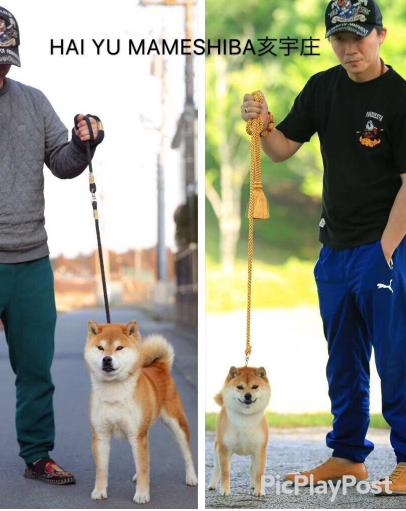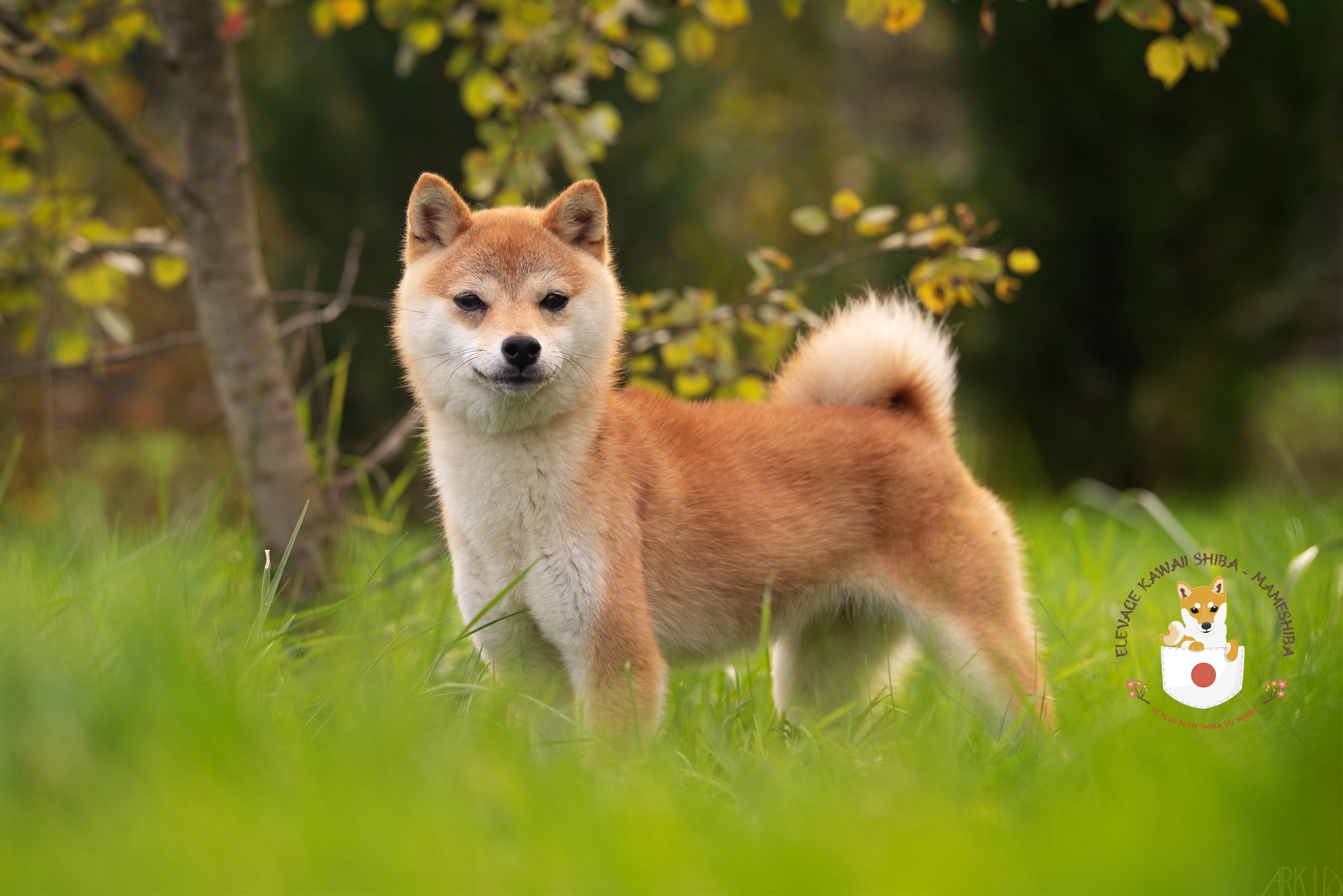LE MAMESHIBA
DESCRIPTION ET INFORMATIONS SUR LA RACE MAMESHIBA
Le SHIBA INU est une race recconue au LOF, il fait partie du groupe 5 » chiens de type spitz et de type primitif / section 5 : Spitz asiatiques et races apparentées.
C’est en sélectionnant les individus SHIBA INU trop petits pour entrer dans le standard et en les reproduisant entre eux à partir de l’année 1950 que les débuts de la création de la race MAMESHIBA a débuté en 2008 en suivant le standard établi par le KCJ (KENNEL CLUB OF JAPAN / CLUB DE RACE OFFICIEL JAPONAIS)
- La taille au garrot d’un SHIBA INU Mâle : 39,5cm ( tolérance de 1,5cm en plus ou en moins)
- SHIBA INU Femelle : 36,5cm ( tolérance de 1,5cm en plus ou en moins)
- La taille au garrot d’un MAMESHIBA Mâle : 25 à 34cm
- MAMESHIBA Femelle : 25 à 32cm

Chaque reproducteur devra obtenir une certification grâce à la confirmation de son chien a l’âge de plus d’un an.
LE STANDARD DU MAMESHIBA

STANDARDS OF THE BREEDS NON SPORTING GROUP
Mameshiba
International Group and Size (Mameshiba)
The dog official recognition organization is only The Kennel Club of Japan on October 1 2015.
Country/Club: Japan/ KCJ
Group: (VI) Non-Sporting
Height: 25~34cm
Weight: No standard
Remarks: The dog’s height is less than 25cm is accepted if both mind and body is healthy no matching with other breed and it is approved is Mameshiba.
Over the several generations, Japanese has been breeding Mameshiba by mating more small Shiba Inu to fit the modern style of living which they have been loved and bred for ancient times. The genetic traits of Mameshiba inherit characteristics of Shiba Inu significantly. For example Mameshiba is a primitive and noble dog and also docile to everyone. In spite of small dog, dignified looks of Mameshiba like an old-samurai and the agility are same as Shiba Inu, in addition Mameshiba is the breed with cuteness by breed down in size.
General Appearance:
Mameshiba inherits characteristics of Shiba Inu. Ancestors dog exhaustively and although the appearance is equal to Shiba Inu. Mameshiba has a bright and friendly as a house pet. The character must not to be shy. In the appearance of Mameshiba, dog must seem to be dog and bitch must seem to be bitch and neutral appearance is not good.
Body:
The ratio of an ideal body is that height is ten, length is eleven, and limbs that support the body are strong and to have toned muscle is good.
Head:
Mameshiba has a head, matching the body and the face of the front seems a slightly rounded compared with Shiba Inu. Forehead is favorably broad and flat. It is not good to be narrow and wrinkled.
Face:
The face of Mameshiba, breeding down in size, must to be cute in proportion to the body, compared with intrepid looks of Shiba Inu. Stop is slightly deep compared with Shiba Inu and full cheeks are good. Dog is strong and bitch is gentle and dog and bitch are elegant.
Ears:
Fairly small, triangular, held erect and slightly forward, inside is straight line, outside is slightly rounded. The width and length of ears are suitable size, matching the face is good and extremely narrow, broad, large, small are not good. And thick ears is good.
Eyes:
Dignified, slightly triangular, dark brown color are good. Rounded eyes are not good.
Nose:
Nose is black on all coat colors . The pink and pinto colors are not good. Nose is wet when acting. The shape of nose that is set up small is good.
Muzzle:
Both dog and bitch‘s muzzle length is 40% of the total head length from stop to bridge of nose, and is 60% of the total head length from stop to occiput is very good. Muzzle is rounded and strong that is required. The bitch’s muzzle is narrow than the dog’s muzzle. The bridge of muzzle is straight. Its color is black and deep black.
Teeth:
Bite is scissors, with a complete of strong. Overshot and undershot and missing teeth are very serious fault.
Neck:
Neck is thick, sturdy, and broad in range of motion and must have a strong appearance enough to support.
Chest:
Robust muscular development is egg-shaped. Flat and rounded body is not good. The depth of chest which is the half of the height is required. Strong is good.
Back:
Straight back, strong.
Loin:
Loin is rich width. It is strong and straight to the hip. The muscle of loin to hip is developed enough. It is necessary that loin is should maintain stability and physical capabilities.
Abdomen:
It is tucked-up gently from the chest and to have a firm outline by fully developed abdominal muscle and back muscle is good. It is not good that the abdomen is too thin.
Forelimb:
The scapula inclines at the back and connected with vertebrae and ligaments. The scapula joint connected with humeral at the angulation that can show physical capabilities and is covered with the developed muscle. Forelimb seen from the front has become vertical in shoulder width. The tight toes are together small and are moderately thick.
Hindlimb:
The hindlimb has a strong structure and must be well developed than the forelimb. Because the hindlimb obtain a driving force. The hocks joint has a moderate angulation with a powerful and strong and stay.
Tail:
Tail is thick and powerful and is carried over the back. The bottom of tail is short and straight and the shape of tail is culled tail or sickle tail to the top of tail. Other is not good. The shape and size are well balanced with body, in length the tail nearly to the hock joint when extended. The shape of tail must be settled well.
Coat:
Mameshiba has double coat with outer coat and undercoat. The outer coat must be stiff and straight. The soft coat and the waved coat are not good. The under coat is thick and fluffy.
Color:
Red, Black, Sesame, White. Red Black and Sesame must be urajiro(cream to white ventral color) . Red is from red brown to light red. Black is good for elegant in position and shape of pinto and white color. Outer coat color becomes darker gradually with white, red, and the black from the end of the hair. For this reason it looks an unpolished black to be seen from a distance. It is not good to look red hair to tip of hair. Pinto has a purpose of pseudo eye to protect themselves from enemies. Black is good that two white spot over the eye are clearly and the size are moderate. Red and Sesame thinly have the characteristic. The borderline between white and black hair on the jaw is clear and straight. The width of borderline should be suitable. The white hair of chest is completely separated from the white hair under the jaw. Sesame is black-tipped hairs on a red background. It is good that the black-tipped hairs reach the head. White is not pure but is light cream colored. It should be noted in this hair color is that the surface of the nose and lip must be black and the color of eye must be dark brown or black.
Gait:
The movement is nimble and light. The gait has a lot of looks of Shiba Inu, the ancient dog. It is full of simplicity and elegance.
THE KENNEL CLUB OF JAPAN
The produce of Mameshiba:
A Japanese dog is an old Japan dog with which ancient times have lived for a long time with the Japanese. Shiba Inu was a generic name of the small size dog in the Japanese dog distributed in Japan. The especially small Shiba Inu was kept by farmers with side-line business of hunting and agriculture and used as a hound dog of small animals which live in the hole as rabbit, raccoon dog, fox, marten and badger in Japan’s mountainous area before World War II.
And so we thought the especially small Shiba Inu almost disappeared during World War II.
Mameshiba started from the breeding of a small Shiba Inu than the standard by ‘Tarui-So’ in Kyoto from around 1950. The late Mr. Masanobu Nishiyama of the kennel of Sesshu Hozan-so took over the breeding of Mameshiba. The late Mr. Masanobu Nishiyama was named an executive at THE KENNEL CLUB OF JAPAN.
The very importance is to confirm the size measurement including dog ancestry and the fixation of this breed and it described to all 3- generations described to a certified pedigree to be fixed for the breed of Mameshiba and the size was described to proof of Mameshiba standard Size. To recognize Mameshiba, it was assumed to be a condition to pass All Mameshiba Standard Certification at age 1 year or more. We have established the severest certification system of Mameshiba in the world.
It was considered that recognition of a new breed is demands of society and times.
Because indoors keeping the dog increases and dog owner’s aging advanced and keeping a small dog in the condominium such as apartment houses increased.
We promoted that the recognition of the first new breed of us in the name of ‘Mameshiba’ by which social awareness has already established to the world on November 1, 2008.
Currently, there is about 5,000 Shiba Inu of Mameshiba Standard passing with which the size filled regulations. However the dog that all of 3-generations passed and was issued by the certified pedigree name of ‘Mameshiba’ 228 in 2012,509 in 2013,1,071 in 2014and 2015 years are about 1,000 for 6months. The number of Mameshiba doubles every year
Mameshiba is an extremely valuable breed.
Breeders to breed Mameshiba will be given to the honor to join the fixing the breed of Mameshiba in the future.
Notice:
If a person who living abroad to import ‘Mameshiba’ from JAPAN, Please confirm ‘whether to be described as ‘Mameshiba’in ‘BREED’ column’ of the certified pedigree.
Even if the name of the breed ‘Shiba Inu’ can not be changed to ‘Mameshiba’in certified pedigree, because there is no accrediting agency in foreign countries even if Shiba Inu has passed Mameshiba Standard.
Organization that recognized ‘Mameshiba’ is only KC
http://www.kcj.gr.jp/